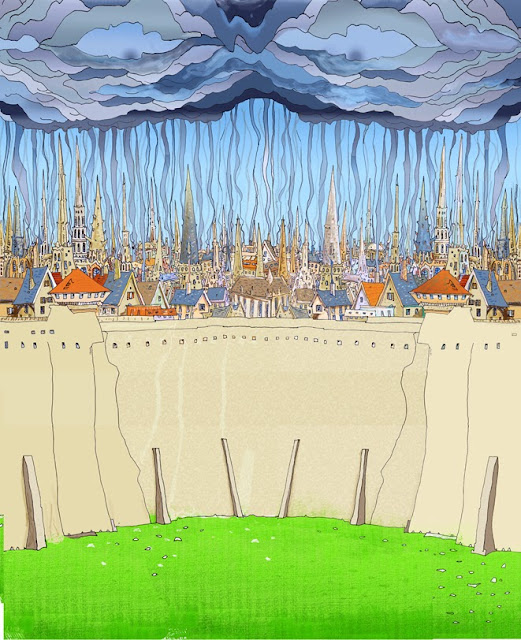Following on from Part One this will show how different parts of the final cover came into being.
I wanted to try out a slightly different way, for me, of working, which would allow me the opportunity to A] be more adaptable about the compositional organisation of the layout and B] meant that if John [Whitbourn], the author, wanted any changes, or was to point out any suggested improvements, these could be adapted as part of the layout without major change.
Having gathered information to support the look of the costumes, the figures, the back grounds and the gargoyle motifs I set out to make sketches, which were first developed into tighter drawings before being inked as line artwork that I could scan then colour.
So where did I start? What I wanted was to work out the frame for the main images chosen for the front and back cover these, I hoped, would add to the Neo-Tudor/Gothic atmosphere I wanted to suggest.
I started with the Gargoyles. In the following pictures you'll see some of the sketches, the selections and the initial colourings.









I wanted to try out a slightly different way, for me, of working, which would allow me the opportunity to A] be more adaptable about the compositional organisation of the layout and B] meant that if John [Whitbourn], the author, wanted any changes, or was to point out any suggested improvements, these could be adapted as part of the layout without major change.
Having gathered information to support the look of the costumes, the figures, the back grounds and the gargoyle motifs I set out to make sketches, which were first developed into tighter drawings before being inked as line artwork that I could scan then colour.
So where did I start? What I wanted was to work out the frame for the main images chosen for the front and back cover these, I hoped, would add to the Neo-Tudor/Gothic atmosphere I wanted to suggest.
I started with the Gargoyles. In the following pictures you'll see some of the sketches, the selections and the initial colourings.



You'll note, when you see the final work, that a lot of flipping of image was used.
Then I started work on the background images for each panel back and front. First the 'church' and then the city.

... then assembled together. Below is the first try out to check balance and composition.
The background panel need a view of London to act as background to Trevan.

Now it was the turn of the figure elements front and back. Several changes were made here including discussion with John where a couple of small but relevant changes were tried before settling on the second eyeball.

The hero Travan.

Finally came the full assembly of the panels

Then the text and gargoyle surrounds were added.
Till finally we had a full colour proof to be accepted by John [Whitbourn] the author and Dave [Morris] who is over seeing the production.

That done I was then sent a copy of the final proof that came back from the printers.
So there you have it ... the genesis of a book cover. Some might say what a long winded way to do it, and some may not, but it's the way I did it.
Till the next time.




















